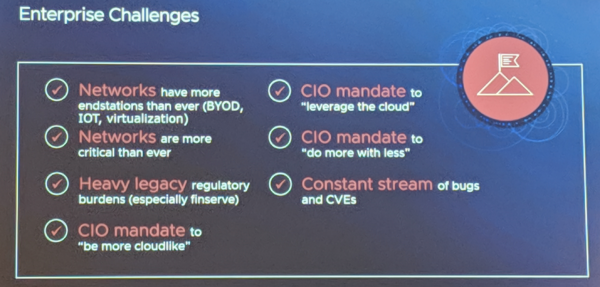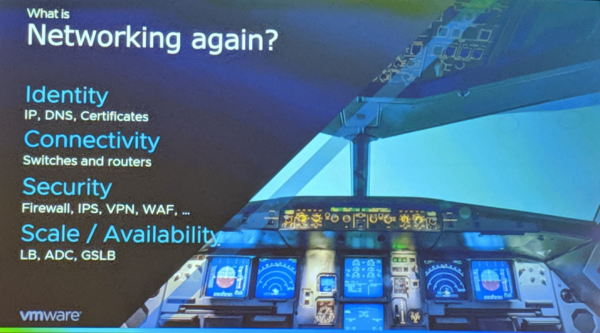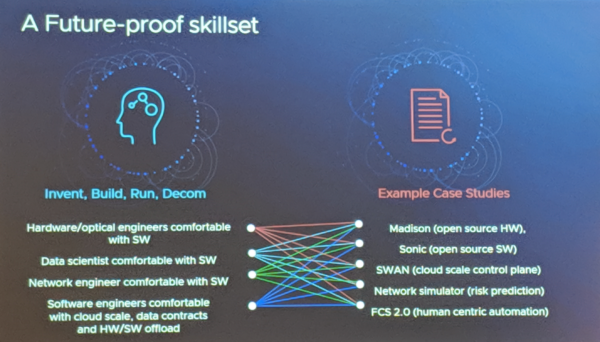I had the opportunity to attend VMware’s Future:NET in San Francisco, CA and it was truly a privilege. So, as all of us who were there settle back into our homes, offices, I’d like to take some time to reflect on what was presented and what we learned.
While this was the first time Future:NET was held in California, it was actually the fourth time that VMware has hosted their one-day conference on the future of networking. In fact, you can find videos of all the past year’s presentations and conversations on YouTube!
But wait, I can hear some of you asking… What is Future:NET?
Future:NET – a Premier Networking Event
Future:NET 2019, like the three before it, was a “premier networking technology event” that earned its title by banning product pitches and instead bringing together world-class networking experts from enterprises, startups, academia, and vendors, to have a frank and candid conversation about the current and future state of networking. It was amazing to be in the presence of so many of networking’s brightest minds – both on stage and in the audience!
The format of the event was very interactive, which is part of what made being there so rewarding. From live audience polls about key questions to lots of audience Q&A, the day was full of open, and often spirited, discussion.
This year’s theme was focused on the question: “Are we really making things simple?” The idea of complexity is one that has been discussed for a long time in the networking industry. As we move into a new age of cloud, edge, mobile, disaggregation, virtualization, automation, and digital transformation, this question is becoming even more important. How do we, as network professionals, ensure that we are not only building networks that enable a new generation of organizations and businesses ever more dependent on information technology, but that are also easier to secure, operate, and scale?
Let’s dive into Future:NET 2019 and see if we can find some clues!
The wizards of networking predict architectural shifts to happen by 2025
The first session of the day was one of the best. It’s always fun to make predictions. It’s even better to hear from some of the true wizards in an industry about what they see in their own crystal balls. And wizards they were. This panel brought together a truly all-star cast of thought leaders from a diverse set of organizations:
Ken Duda, @ken_duda– CTO/SVP Software Engineering / Arista
Albert Greenberg, @AlbertGreenberg —Corporate VP/ Microsoft Azure Networking
Bikash Koley, @bikashkoley73– CTO & Executive Vice President / Juniper Networks
Nick McKeown, @nickmckeown1—Professor / Stanford University
Pere Monclus—CTO Network and Security / VMware
Vijoy Pandey, @vijoy —VP & CTO, Cloud & Distributed Systems / Cisco Cloud
The moderator set the stage by describing the last 10 years through three key trends:
- Deployment at scale in large cloud data centers (hyper-scalers)
- Software becoming more important (SDN, virtualization)
- Hardware being rapidly standardized (merchant silicon)
He then opened up the lightning round by asking the panelists to each give their vision for the next 5-6 years.
First up was Nick McKeown (who you may remember as one of the founders of Nicira Networks). He characterized networking in 2019 as a time of scale, robustness, and crazy hard problems. But how did we get here? According to Nick, in 2008 much of networking was closed proprietary and poorly structured, and this was exacerbated by a proliferation of standards that gave vendors “a stranglehold” and created a huge barrier to entry for new networking vendors. Something had to change. And it did. From 2008 to 2019 we saw network owners take control of their software, first in the data center, and more recently in telcos as well. This led us to the current state of disaggregation, SDN, NFV, telemetry, and of tangible open source networking. He said we are now seeing part two of this shift, as network owners take control of packet processing through protocols like P4.
What else did Nick predict? Well, first I have to note that, like any good academic, Nick took the prediction out a bit further. He decided to look 10 years down the road and show us what he sees in 2030. On the speeds and feeds side of the coin, Professor McKeown projects huge scale! As much as 1-2 Tbps per port on 400Tbps switch chips with multiple Tbps of CPU I/O capacity and sub 250ns latency. Wow. Because today’s programmable switch chips already have the same cost, power, and performance of non-programable chips, he also projects that in 2030 all switch chips will have been programmable for 10 years – so the network as a programmable platform will be totally normal and stream computation will be routinely accelerated by the network. This also means that software engineering techniques will be normal in networking, and that networking classes will look a lot more like programming classes. And of course, programmability (control) of the network is just half the equation. Nick also sees fine-grained per-packet measurement (visibility) that will allow us to monitor and correct network function and performance in real-time.
It’s hard to follow a presentation like that, but Bikash Koley proved up to the task. He started by walking us through the journey that networks are currently on. According to Bikash, the five stages of this journey are: human-driven (manual), workflow-driven (MoPs written in python or Go), event-driven (very few networks have made it this far), machine-driven (where machine learning makes sense from the behavior of the network), to the ultimate goal of a self-driving network, which he says is doable.

Bikash then dove into the specifics of intent-driven and AI-driven networks. Like Nick, Bikash highlighted the need for the right abstractions, and for fine-grained telemetry (and the ability to make sense of it). Dr. Koley finished up with a look at open networking, reminding us that open is core to innovation (the only way to get to a self-driving network) and predicting that open APIs and open data-models will be the norm by 2025.
Next up was Vijoy Pandey who asked us all to stop cheating! Like Nick, he reminded us that networking vendors started as box builders, adding layers and layers of features (complexity) and then connected those boxes, and that complexity globally. We’ve now started simplifying things by separating hardware and software, while also moving to algorithms instead of protocols. We’ve modeled the physical, formalized those models, and automated our networks. But something isn’t quite right. Just as the first wave of application virtualization moved physical workloads to virtual ones without making any real operational changes, us networkers have cheated, too. We’ve stuffed the physical into the virtual without changing our protocols, or our organizations. He called on us to observe the changes in application architecture and how they are now creating changes in operational and organizational architectures as well. Vijoy says we need to re-think networking in this cloud-native world with a focus on connectivity and think about application-specific forwarding and security.
Ken Duda pointed out that there are multiple segments within the networking industry and chose to hone in on the Enterprise specifically. To kick this off, he laid out the challenges facing enterprise IT teams, such as the explosion of end stations (BYOD, IoT, virtualization), the ever-increasing criticality of the network, and all of the mandates to “leverage the cloud” or “be more cloudlike” -just to name a few.

Building from these challenges, Ken made a three-part call to arms for network device makers: First, focus on quality. That’s really what customers are paying for. Simplicity has to be number two. He says there is just too much junk out there – patches, versions, proprietary features, etc. Thirdly, focus on manageability; network management has always been a backwater and today networks are harder to operate than to build. The rest of his presentation focused on this last challenge, describing his vision for a “cognitive management plane” that takes what we’ve done in the forwarding and control planes and applies it to management. The result may not be a single pane of glass he said, but at least it can be a single plane.
Then it was time for VMware’s own Pere Monclus to take the podium. His presentation was a bit more of an introspective for all of us in the room. What is networking? Is it just connectivity?

Pere focused in on the difference between cost and value. Cost, he said, is related to connectivity, but value is found in exchanging information and context – communication, in other words. He asked other questions about how to tame complexity, and whether or not we’re having the right discussion when it comes to automation and orchestration. Like most of the speakers before him, Pere made reference to the changes happening in applications and in organizations. Specifically, the shift from legacy monolithic applications to modern continuous delivery modalities and the related organizational shift from being infrastructure-centric to being application-centric. His conclusion? The world is changing, and we must change with it, from focusing on the IT fabric to focusing on business needs, from focusing on pipes to focusing on communications. In other words, we must focus on the value of what we are building.
The final wizard to speak on this panel was Albert Greenberg, who rounded out the session with a look at the industry’s talent needs for the future. According to Albert, the teams we need are multi-disciplinary, diverse, and inclusive and the people we need are open-minded, creative, and problem-solving. I can’t agree more! He summed up his view of a “future-proof skillset” on the slide below, which I further summed up in a tweet where I wrote: Future proof skillset = “…comfortable with SoftWare.”

Of course, that was just the presentations, there was also tons of great Q&A back and forth in the room that added greatly to everything presented. And this was just the first session!
Future:NET 2019 – A packed day of amazing networking content and networking opportunities.
Throughout the rest of the day, we heard from Joe Skorupa, Omar Baldonado, Dino Farinacci, Arpit Joshipura, John Pescatore, Forrest Bennett, Lane Patterson, Mike Frane, Andrew Clay Shafer, David Erickson, Mansour Karam, Cameron Haight, Grant Dasher, and Stephan Massalt. They covered topics including automation, SLAs, simplicity, NOCs and SOCs, security, branch networks, and IT organizational structure.
Being in the room with some of the brightest minds in networking and speaking with them about some of the toughest challenges we face was an amazing experience that will fuel me until it’s time for next year’s Future:NET.
If you didn’t get a chance to attend this year, I highly recommend that you add it to your calendar for next year! See you there.


